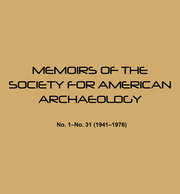No CrossRef data available.
Article contents
IV. The Results of the Experiment
Published online by Cambridge University Press: 27 June 2018
Extract
The data generated by the methods described in Chapter III are summarized in this chapter in terms of the problem of this paper. As stated by Lloyd, the problem concerns the validity of conclusions based on a discontinuous intensive survey. In this study, 326 discontinuous intensive surveys are simulated on paper, and the results are interpreted in terms of the 3 aspects of the sampling process–sampling scheme, fraction, and unit. Which alternative of each aspect of the sampling process is more likely to produce valid conclusions? I hope that an empirically based answer to this question will assist archaeologists who want to survey complete regions, but are forced to sample because of temporal and financial limitations.
Chi square and economy are useful for evaluating each simulated sample and for comparing each sample to the population. As outlined in the previous chapter, the experiment generated 326 samples. For each sample, a chi-square value for each of 5 variables and 1 number representing economy are calculated. Thus, the data used to answer the question of this study consist of 1,680 chi-square values and 326 values of economy.
- Type
- Research Article
- Information
- Copyright
- Copyright © Society for American Archaeology 1974


